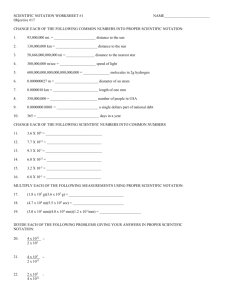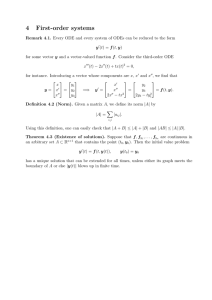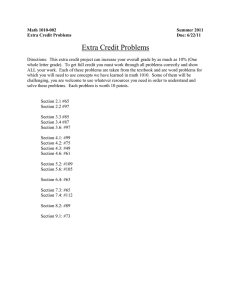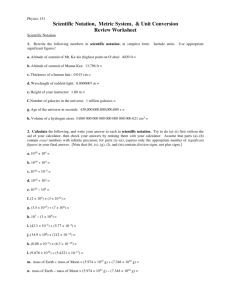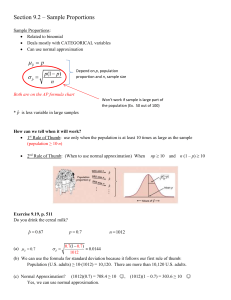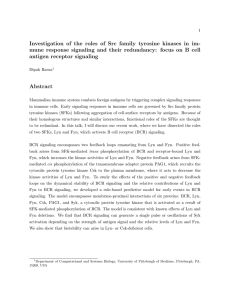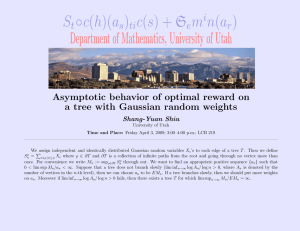Solutions to Homework 2 6.262 Discrete Stochastic Processes
advertisement
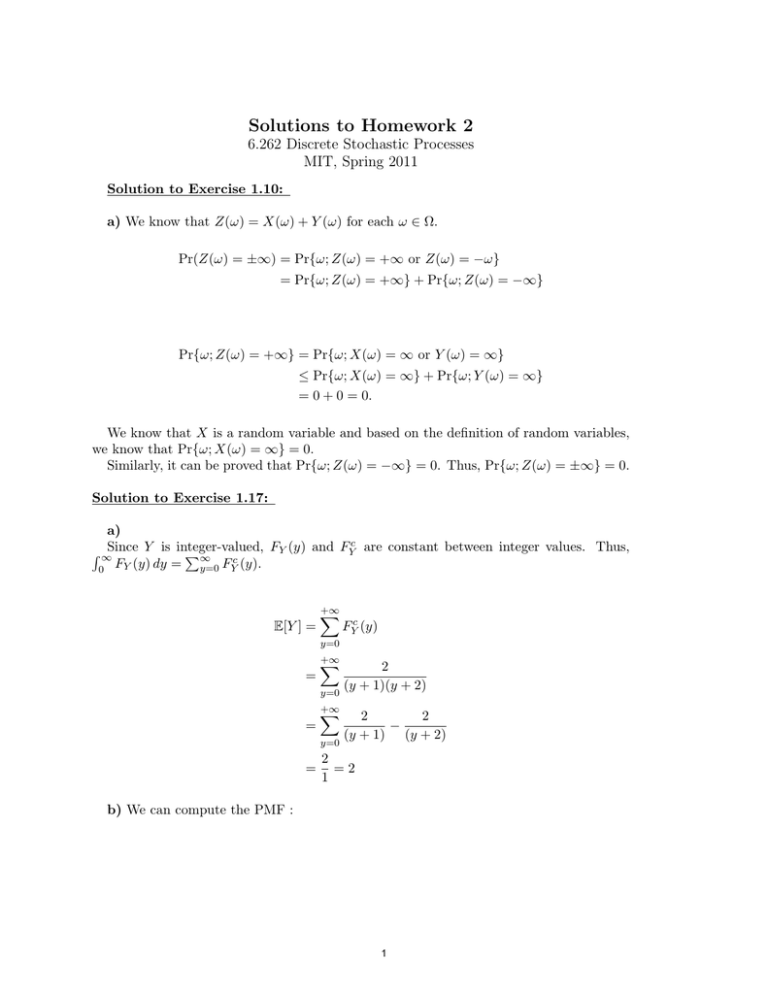
Solutions to Homework 2
6.262 Discrete Stochastic Processes
MIT, Spring 2011
Solution to Exercise 1.10:
a) We know that Z(ω) = X(ω) + Y (ω) for each ω ∈ Ω.
Pr(Z(ω) = ±∞) = Pr{ω; Z(ω) = +∞ or Z(ω) = −ω}
= Pr{ω; Z(ω) = +∞} + Pr{ω; Z(ω) = −∞}
Pr{ω; Z(ω) = +∞} = Pr{ω; X(ω) = ∞ or Y (ω) = ∞}
≤ Pr{ω; X(ω) = ∞} + Pr{ω; Y (ω) = ∞}
= 0 + 0 = 0.
We know that X is a random variable and based on the definition of random variables,
we know that Pr{ω; X(ω) = ∞} = 0.
Similarly, it can be proved that Pr{ω; Z(ω) = −∞} = 0. Thus, Pr{ω; Z(ω) = ±∞} = 0.
Solution to Exercise 1.17:
a)
teger-valued, FY (y) and FYc are constant between integer values. Thus,
� ∞Since Y is in�
∞
c
y =0 FY (y).
0 FY (y) dy =
E[Y ] =
+∞
�
FYc (y)
y=0
=
+∞
�
y=0
=
+∞
�
y=0
=
2
(y + 1)(y + 2)
2
2
−
(y + 1) (y + 2)
2
=2
1
b) We can compute the PMF :
1
pY (y) = FY (y) − FY (y − 1)
2
2
=1−
− (1 −
)
(y + 1)(y + 2)
y(y + 1)
4
=
, ∀y > 0.
y(y + 1)(y + 2)
+∞
�
E[Y ] =
y.pY (y)
y=1
+∞
�
=
y=1
+∞
�
=
y=1
4
(y + 1)(y + 2)
(
4
4
4
−
) = = 2.
(y + 1) (y + 2)
2
c) Condition on the event [Y = y], the rv X has a uniform distribution over the interval
[1, y]. So, E[X|Y = y] = (1 + y)/2.
E[X] = E[E[X|Y = y]] = E[
pX (x) =
=
=
y=∞
�
pX |Y (x|y )pY (y)
y=1
y�
=∞
y=x
=∞
y�
y=x
1+y
1 + E[y]
]=
= 3/2
2
2
y 2 (y
4
+ 1)(y + 2)
−3
2
4
1
+ 2+
−
y
y
y+1 y+2
It’s too complicated to calculate this term.
d) Condition on the event [Y = y], the rv Z has a uniform distribution over the interval
[1, y 2 ]. So, E[X|Y = y] = (1 + y 2 )/2.
∞
1 + y2
1 1�
4y
E[Z] = [
]= +
=∞
2
2 2
(y + 1)(y + 2)
y=1
Solution to Exercise 1.31:
a)
We know that:
2
�
0
erx dF (x) ≤
|
0
�
−∞
|erx | dF (x)
−∞
And if r ≥ 0, for x < 0, |erx | ≤ 1. Thus,
0
�
rx
|
e
0
�
dF (x)| ≤
−∞
dF (x) ≤ 1
−∞
Similarly, when r ≤ 0, |erx | ≤ 1 for x ≥ 0
� ∞
� ∞
�
rx
rx
|
e dF (x)| ≤
|e | dF (x) ≤
0
0
∞
dF (x) ≤ 1
0
b) We know that for all x ≥ 0, for each 0 ≤ r ≤ r1 , erx ≤ er1 x . Thus,
� ∞
� ∞
rx
er1 x dF (x) < ∞
e dF (x) ≤
0
0
c) We know that for all x ≤ 0, for each r2 ≤ r ≤ 0, erx ≤ er2 x . Thus,
�
0
rx
e
�
0
dF (x) ≤
−∞
er2 x dF (x) < ∞
−∞
d) We know the value of gX (r) for r = 0:
�
0
gX (0) =
�
dF (x) +
∞
dF (x) = 1
−∞
0
So for r = 0, the moment generating function exists. We also know that the first integral
exists for all r ≥ 0. And if the second integral exists for a given r1 > 0, it exists for all
0 ≤ r ≤ r1 . So if gX (r) exists for some r1 ≥ 0, it exists for all 0 ≤ r ≤ r1 . Similarly, we
can prove that if gX (r) exists for some r2 ≤ 0, it exists for all r2 ≤ r ≤ 0. So the interval
in which gX (r) exists is from some r2 ≤ 0 to some r1 ≥ 0.
e) We note immediately that with fX (x) = e−x for x ≥ 0, gX (1) = ∞. With
fX (x) = (ax−2 )e−x for
� ∞x ≥ 1 and 0 otherwise, it is clear that gX (1) < ∞. Here a is
taken to be such that 1 (ax−2 )e−x dx = 1.
Solution to Exercise 1.33:
Given that Xi ’s are IID, we have E[Sn ] = nE[X] = nδ and V ar(Sn ) = nV ar(X) = nσ 2
where V ar(X) = σ 2 = δ(1 − δ). Since V ar(X) <
√∞, the CLT implies that the normalized
version of Sn , defined as Yn = (Sn − nE[X])/( nσ) will tend to a normalized Gaussian
3
distribution as n → ∞, so we can use the integral in (1.81). First let us see what is
happening and then we will verify the results.
√
a) The standard deviation of Sn is increasing in n while the interval of the summation
is a fixed interval about the mean. Thus, the probability distribution becomes flatter and
more spread out as n√
increases, and the probability of interest tends to 0. Analytically, let
Yn = (Sn − nE[X])/( nσ), then,
�
(1)
i:nδ−m≤i≤nδ+m
m
m
Pr {Sn = i} ∼ FSn (nδ + m) − FSn (nδ − m) = FYn ( √ ) − FYn (− √ )
nσ
nσ
For large n, Yn becomes a standard normal,
�
m
m
(2)
lim
Pr {Sn = i} = lim (FYn ( √ ) − FYn (− √ )) = 0
n→∞
n→∞
nσ
nσ
i:nδ −m≤i≤nδ+m
Comment: To be rigorous, which is not necessary here, the limit in (2) is taken as follows.
We need to show that FYn (yn ) → Φ(y) (Φ is the cumulative gaussian distribution), where
the sequence yn → y and the functions FYn → Φ (pointwise). Consider an � > 0 and
pick N large enough so that for all n ≥ N we have y − � ≤ yn ≤ y + �. Then we get,
FYn (y − �) ≤ FYn (yn ) ≤ FYn (y + �), ∀n > N (since FYn is non-decreasing). Take the limit
n → ∞ which gives Φ(y − �) ≤ limn→∞ FYn (yn ) ≤ Φ(y + �) (by CLT). Now, take the limit
� → ∞ and since Φ(.) is a continuous function, both sides of the inequality converge to the
same value Φ(y) which completes the proof.
b) The summation here is over all terms below the mean plus the terms which exceed
the mean by at most m. As n → ∞, the normalized distribution (the distribution of Yn )
becomes Gaussian and the integral up to the mean becomes 1/2. Analytically,
lim
n→∞
�
i:0≤i≤nδ+m
m
−nδ
Pr {Sn = i} = lim (FYn ( √ ) − FYn ( √ )) = 1/2
n→∞
nσ
nσ
c) The√
interval of summation is increasing with n while the standard deviation is increas­
ing with n. Thus, in the limit, the probability of interest will include all the probability
mass.
lim
�
n→∞
i:n(δ−1/m)≤i≤n(δ+1/m)
−n
n
Pr {Sn = i} = lim (FYn ( √ ) − FYn ( √ )) = 1
n→∞
m nσ
m nσ
Solution to Exercise 1.38:
We√know that Sn√is a r.v. with mean 0 and variance nσ 2 . According to CLT, both
Sn /σ n and S2n /σ 2n converge in distribution to normal distribution with
√ mean 0 and
√
variance 1. But this does not imply the convergence of Sn /σ n − S2n /σ 2n.
4
√
2Sn − S2n
√
σ 2n
√ �n
�
2 i=1 Xi − 2n
i=1 Xi
√
=
σ 2n
�2n
√
�n
Xi
1
2−1
i=n+1 Xi
i=1
√
√
=( √ )
−√
σ n
σ n
2
2
�
�
Independency of Xi ’s imply the independency of Sn = ni=1 Xi and Sn� = 2n
i=n+1 Xi .
√
√
�
Both Sn /(σ n) and Sn /(σ n) converge in distribution
to zero mean, unit variance nor­
√
) σS√nn converges to a normal r.v.
mal distribution and they are independent. Thus, ( √2−1
2
√
�
with mean 0 and variance 3/2 − 2 and is independent of ( √12 ) σS√nn which converges in
distribution to a normal r.v. with mean 0 and variance 1/2.
So, σS√nn − σS√2n2n converges in distribution to a normal r.v with mean 0 and variance
√
2 − 2. This means that σS√nn − σS√2n2n does not converge to a constant and it might take
different values with the described probability distribution.
Sn
S
√ − √2n =
σ n σ 2n
Solution to Exercise 1.42:
a)
X̄ = 100
2
= (1012 − 100)2 × 10−10 + (100 + 1)2 × (1 − 10−10 )/2 + (100 − 1)2 × (1 − 10−10 )/2
σX
= 1014 − 2 × 104 + 104 ≈ 1014 .
Thus,
S¯
n = 100n
σS2 n = n × 1014
b) This is the event that all 106 trials result in ±1. That is, there are no occurrences of
6
12
10 . That is, there are no occurrences of 1012 . Thus, Pr Sn ≤ 106 = (1 − 10−10 )10 .
c) From the union bound, the probability of one or more occurrences of the sample
value 1012 out of 106 trials is bounded by a sum over 106 terms, each of which is 10−10 ,
i.e., 1 − FSn (106 ) ≤ 10−4 .
d) Conditional on no occurrences of 1012 , Sn simply has a binomial distribution. We
know from the central limit theorem for the binomial case that Sn will be approximately
Gaussian with mean 0 and standard deviation 103 . Since one or more occurrences of 1012
occur only with probability 10−4 , this can be neglected, so the distribution function is
approximately Gaussian with 3 sigma points at ±3 × 103 .
5
Figure 1. Distribution function of Sn for n = 106
e) First, consider the PMF pB (j) = of the number B = j of occurrences of the value
1012 . We have
� 10 �
10
10
pB (j) =
q j (1 − q )10 −j
j
−10
where q = 10 .
10
pB (0) = (1 − q)10
= exp(1010 ln [1 − q]) ≈ exp (−1010 q) = e−1
10 −1
pB (1) = 1010 q(1 − q )10
10 −1
= (1 − q)10
≈ e−1
� 10 �
1010 × (1010 − 1) −10 2
1
10
10
10
pB (2) =
q 2 (1 − q)10 −2 =
(10 ) (1 − 10−10 )10 −2 ≈ e−1
2
2
2
Thus,
Pr (B ≤ 2) ≈ 2.5e−1
Conditional on {B = j}, Sn will be approximately Gaussian with mean 1012 j and stan­
dard deviation of 105 . Thus FSn (x) rises from 0 to e−1 over a range of x from about
−3 × 105 to +3 × 105 . It then stays virtually constant up to about x = 1012 − 3 × 105 .
It rises to 2e−1 by about x = 1012 + 3 × 105 . It stays virtually constant up to about
2 × 1012 − 3 × 105 and rises to 2.5e−1 by about 2 × 1012 + 3 × 105 . When we sketch this,
the rises in FSn (x) for n = 1010 over a width of about 6 × 105 look essentially vertical on a
6
scale of 2 × 1012 , rising from 0 to e−1 at 0, from 1/e to 2/e at 1012 and from 2/e to 2.5/e
at 2 × 1012 . There are smaller steps at larger values, but they would scarcely show up on
this sketch.
Figure 2. Distribution function of Sn for n = 1010
f ) It can be seen that
� for this peculiar rv, Sn /n is not concentrated10around its mean even
10
for n = 10 and Sn / (n) does not look Gaussian even for n = 10 . For this particular
distribution, n has to be so large that B, the number of occurrences of 1012 , is large, and
this requires n � 1010 . This illustrates a common weakness of limit theorems. They say
what happens as a parameter (n in this case) becomes sufficiently large, but it takes extra
work to see how large that is.
7
MIT OpenCourseWare
http://ocw.mit.edu
6.262 Discrete Stochastic Processes
Spring 2011
For information about citing these materials or our Terms of Use, visit: http://ocw.mit.edu/terms.
